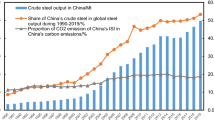Abstract
A new energy intensity (EI) index for steel production—energy intensity at specific scrap ratio (EISR) index—is developed in this study to provide a method for analyzing the EI difference of steel production through a case-study analysis for China and Japan. The real cause of EI change of China’s key steel enterprises from 2006–2014 is also studied by using the EISR index. Result shows significant technology progress decreases the EI of China’s key steel enterprises by 16% from 2006 to 2014, but the final drop of comparable EI was only 12.3% due to the continued decreased scrap ratio (SR). From 2006 to 2014, the main cause of EI gap between China’s key steel enterprises and Japan’s steel industry changed from gap in technological level to difference in SR. In factor analysis that assumed Japanese share of electric arc furnace production (23.2%) and SR (33.3%) in 2014 in China, the EI of China’s key steel enterprises decreased to 612 kgce/t (kilogram standard coal/t) (primary energy consumption), which is almost same as Japan’s data. The key task of energy conservation in China’s key steel enterprises in the future should be changed from upgrading the technology level to increase the SR of steel production.
Similar content being viewed by others
References
Department of Energy Statistics of China. China Energy Statistics Yearbook 2015 (in Chinese). Beijing: China Statistics Press, 2016
Liu X Liao S Rao Z, et al. An input-output model for energy accounting and analysis of industrial production processes: A case study of an integrated steel plant. J Iron Steel Res Int, 2018, 25: 524–538
Sun W Q Cai J J Tao D U, et al. Specific energy consumption analysis model and its application in typical steel manufacturing process. J Iron Steel Res Int, 2010, 17: 33–37
Hasanbeigi A Morrow W Sathaye J, et al. A bottom-up model to estimate the energy efficiency improvement and CO2 emission reduction potentials in the Chinese iron and steel industry. Energy, 2013, 50: 315–325
Kaşka Ö. Energy and exergy analysis of an organic Rankine for power generation from waste heat recovery in steel industry. Energy Convers Manage, 2014, 77: 108–117
Lin B Wang X. Exploring energy efficiency in China’s iron and steel industry: A stochastic frontier approach. Energy Policy, 2014, 72: 87–96
Hasanbeigi A Price L Chunxia Z, et al. Comparison of iron and steel production energy use and energy intensity in China and the U.S. J Cleaner Production, 2014, 65: 108–119
Chen W Yin X Ma D. A bottom-up analysis of China’s iron and steel industrial energy consumption and CO2 emissions. Appl Energy, 2014, 136: 1174–1183
Lin B Wu Y Zhang L. Estimates of the potential for energy conservation in the Chinese steel industry. Energy Policy, 2011, 39: 3680–3689
He K Wang L. A review of energy use and energy-efficient technologies for the iron and steel industry. Renew Sustain Energy Rev, 2016, 70: 1022–1039
National Bureau of Statistics of China. Handbook of Energy Statistics (in Chinese). Beijing: China Statistics Press, 2010
Wang W X. Energy consumption situation and energy saving potential analysis of iron and steel industry. Chin Steel, 2011, 4: 19–22
Zang Y Liu W Zhang J. Accelerating the utilization of scrap to promote energy-saving and emission-reduction of China’s iron and steel industry. Res Iron Steel, 2010, 38: 43–46
Hao Y Q. Study on machanism and model of circular economy in China’s iron and steel industry (in Chinese). Dissertation for Dcotoral Degree. Beijing: University of Science and Technology Beijing, 2014
Cai J J. Energy consumption analysis and energy saving counter-measure research for integrated steel works. Angang Tech, 2009, 2: 1–6
The editorial board of China steel yearbook. China Steel Yearbook. Beijing: Metallurgical Industry Press, 2007–2015
He K Wang L Zhu H, et al. Energy-saving potential of China’s steel industry according to its development plan. Energies, 2018, 11: 948
Author information
Authors and Affiliations
Corresponding author
Additional information
This work was supported by the National Key R&D Program of China (Grant No. 2016YFB0601101).
Rights and permissions
About this article
Cite this article
He, K., Wang, L. Time to change the energy conservation direction of China’s steel industry: From upgrading the technology level to increasing scrap ratio. Sci. China Technol. Sci. 63, 128–139 (2020). https://doi.org/10.1007/s11431-018-9454-0
Received:
Accepted:
Published:
Issue Date:
DOI: https://doi.org/10.1007/s11431-018-9454-0




